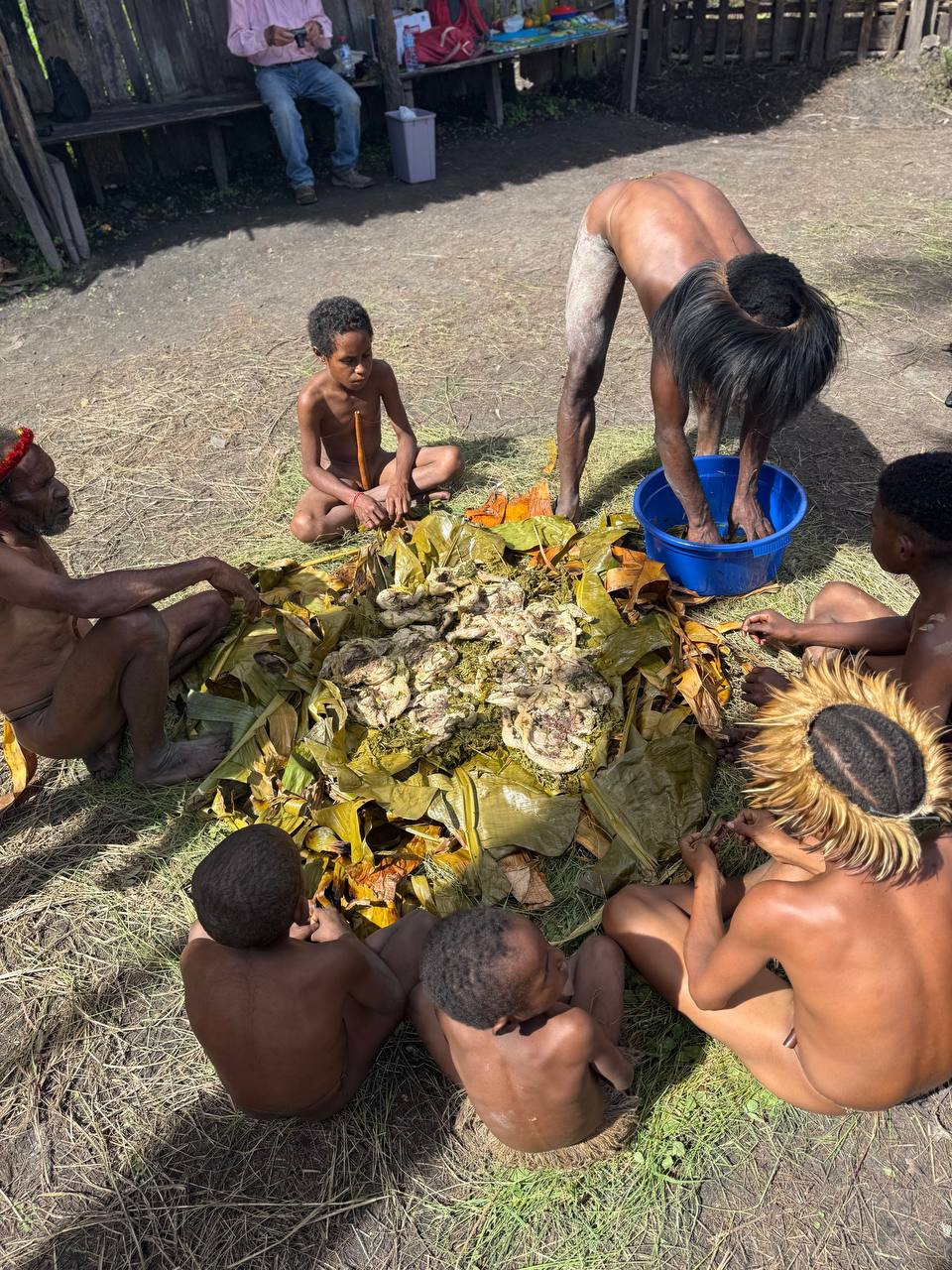Sayur Lilin, also known to some as Jungle Ginger, is one of those foods that looks like it shouldn’t be eaten. Resembling some kind of mossy seaweed, or perhaps shredded bamboo soaked in broth, it’s easy to overlook unless you know what you’re dealing with. But if you’ve ever sat down with the Dani tribe during a mumu feast in Wamena, or wandered through the early morning chaos of a Papuan market, you’ve probably already crossed paths with this little-known jungle gem.
This isn’t a Jakarta dish, or something you’ll find in Bali’s hipster cafes. Sayur Lilin is pure Papua. It’s earthy, simple, and a staple in the highlands where processed food is scarce, and everything comes from your garden or the jungle.
And it is THE way to flavour food in West Papua, unlike Maggi down in PNG.
Table of Contents



What is Sayur Lilin?
Despite the name, Sayur Lilin (literally “wax vegetable” in Bahasa Indonesia) has nothing to do with candles. It’s actually the inner stalk of the young banana flower—specifically the soft white core that’s pulled out and sliced into ribbons. The result is a texture that’s chewy, a bit stringy, and oddly satisfying, especially when it’s soaked in the rich juices of sweet potato, pork fat, and jungle spices.
Locally, it can also be referred to in different tribal dialects. Among the Dani, the name is usually just explained contextually as part of the sayur mix in a mumu. In some mountain villages it’s simply referred to as daun pisang muda or “young banana leaf,” although that’s not entirely accurate. Either way, if you see something green, stringy, and slightly slimy nestled next to your taro and sweet potato, you’re looking at Sayur Lilin.



Sayur Lilin in a Mumu Feast
The mumu is one of the great culinary traditions of the Papuan Highlands. If you’re lucky enough to be invited to a proper one, you’ll witness the entire village come together to cook a feast underground. Hot stones, fresh meat (usually pig), sweet potatoes, taro, cassava, and jungle greens get wrapped in banana leaves and slow-cooked for hours.
Sayur Lilin plays a starring role in this lineup. It’s not just filler—it adds a slightly bitter, vegetal flavour that cuts through the richness of the pork and balances the sweetness of the yam. It soaks up the pork fat and the earthy taste of the stones like a sponge. The texture ends up somewhere between okra and boiled leek.
Eating it by hand, while sitting cross-legged on the grass, surrounded by laughing Dani kids and puffing away on shared tobacco pipes, is about as far away from five-star dining as you can get. And yet, it’s a feast in every sense of the word.



Finding Sayur Lilin in Wamena Market
Wamena’s market scene isn’t massive, but what it lacks in scale it makes up for in personality. Walk into the main market early enough and you’ll see bundles of jungle greens laid out on woven mats. Sayur Lilin isn’t always labeled, but it’s easy to spot. Long, pale-green or white strips curled into mounds, sometimes lightly cooked, sometimes raw and ready to be boiled.
Vendors—usually older women in woven skirts—will give you a sample or tell you how to cook it. In most cases, they’ll recommend simply boiling it in salted water, or if you’ve got access to pork fat, frying it up with chili and ginger. Other vendors are also known to sell it “street food style” with taro and chicken.
You can also find it being served at basic warungs in and around Wamena, often as part of a nasi campur style plate. Pair it with sago, chicken, or smoked fish and you’ve got yourself a properly Papuan lunch.


Other Names, Other Styles
While “Sayur Lilin” is the name you’ll hear most commonly in Bahasa Indonesia, in different regions of Papua it goes by various tribal names. Unfortunately, many of these are hard to pin down as they change from valley to valley. In some parts of the highlands it’s just referred to as part of sayur hutan or “jungle vegetables.”
It’s also sometimes confused with ferns or young bamboo shoots, especially when mixed into a stew. But sayur lilin is distinct because of its banana origin and that almost waxy feel when you bite into it. In some parts of Papua New Guinea (which shares a culinary border with Indonesian Papua), a similar stalk is used in village cooking but is often smoked or dried for storage. In West Papua, it’s mostly served fresh and seasonal.
How to Cook Sayur Lilin (Papuan Style)
If you’re not sitting on the side of a mountain in Wamena, and instead find yourself with some sayur lilin back at your guesthouse, here’s a simple way to cook it:
- Wash it well. Jungle plants often come with friends—bugs, dirt, and other stowaways.
- Boil it with salt, garlic, and ginger until soft.
- If you’ve got access to pork belly or lard, fry the boiled sayur lilin in the rendered fat until lightly crispy.
- Serve with rice, taro, or sweet potato.
Add chili if you want it local style. If you’re doing a veggie version, coconut milk works surprisingly well too.



Final Thoughts
Sayur Lilin is not glamorous. It’s not going to be on the cover of Bon Appétit. But it’s real food, from a place that still eats what it grows. It’s part of the identity of Papua—quiet, green, a little tough, and surprisingly deep once you get past the surface.
If you’re in Wamena or anywhere in the highlands and you get the chance, don’t skip it. Whether in a mumu with the locals, or ladled onto a paper plate in a smoky warung, this jungle vegetable is Papua on a plate.
Click to check out my Indonesian Tours and West Papua Tours with YPT.

